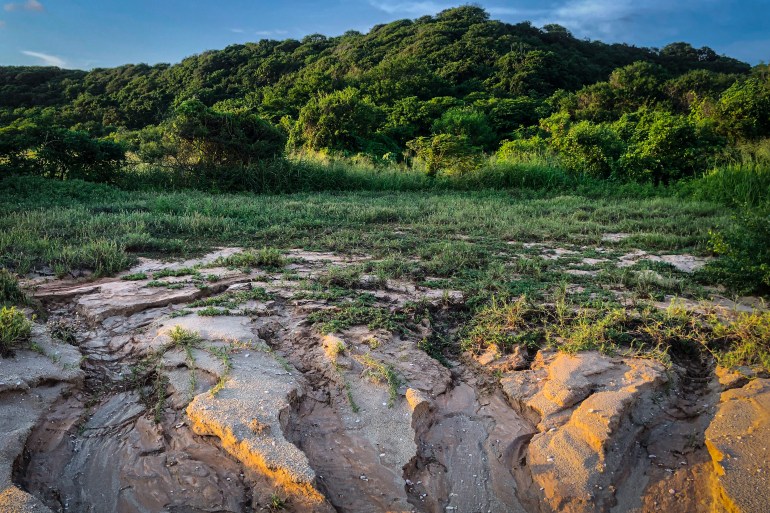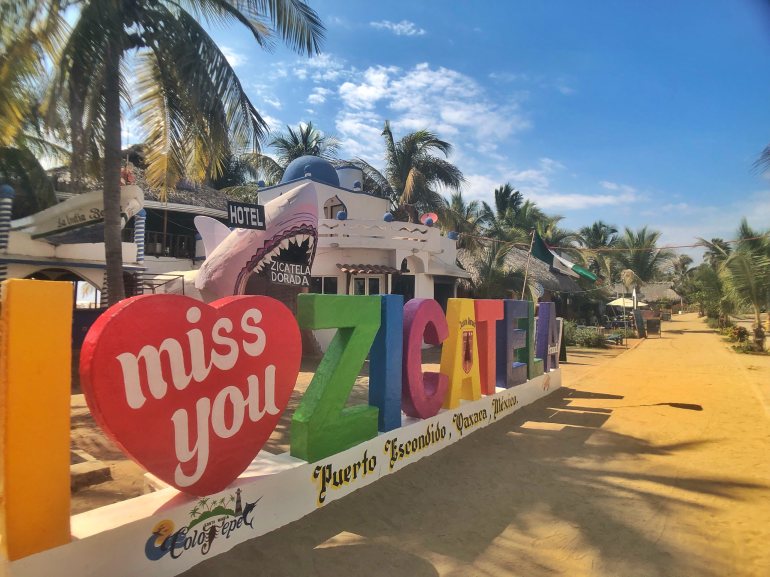Puerto Escondido, Mexico – With its bucolic beaches, lush greenery and kaleidoscopic sunsets, it is not difficult to see why the remote tropical paradise of Puerto Escondido has become so popular.
The coastline, tucked away on the southern Pacific hip of Mexico’s Oaxaca region, is a mecca for surfers, bar hoppers and bohemian beach bums. Wildlife abounds, with pelicans perched on rocky outcroppings, buzzards gliding overhead, turtles and dolphins making appearances at sea and random iguanas scurrying about.
But because so many are choosing to experience this beach oasis, the town faces a problem that plagues similar destinations around the world: the rising tide of tourism and a lack of preparation for it.
A decade ago, Puerto Escondido was a rather unassuming place largely off the international radar, save for a smattering of retirees from North America and surfers from Europe and Australia. But around that time, a flurry of articles drew an abundance of attention to this secluded Shangri-la due to a combination of word of mouth driven largely by the rising influence of Instagram and a boom of tourism across Mexico in general.
Since then, the impact of the town’s growing reputation has become starkly apparent.
In March 2020, many people flocked to Puerto Escondido to wait out the COVID pandemic. The small town swelled with Mexicans escaping the density of Mexico City and people from all over the world fleeing strict COVID restrictions in their countries in favour of Mexico’s more lax approach – borders remained open for the duration of the pandemic, while business closures and lockdowns were relatively brief and inconsistently enforced – and the tranquil shores of Oaxaca.
This influx of temporary residents was a turning point for Puerto Escondido. Construction exploded: hotels, restaurants, bars, dubious dance clubs – the works. The economic dominance of the so-called “digital nomads” skyrocketed rental prices and the cost of living climbed.
Before long, the community was struggling to keep up in the face of unchecked tourism and development.
“It’s grown a little too much” for its own good,” says local graphic artist Orlando Salinas, who grew up visiting Puerto Escondido with his family before moving there in 2017 and has since become involved with various community groups. Salinas notes that while the fast flow of tourism has had economic benefits for those in the industry, “almost every other aspect is being negatively affected”.
“In the last five years, Puerto has experienced a growth in unsustainable tourism with a lack of proper management and regulation, causing a huge impact on the environment and local economy,” says Emmett Balassone, the communications coordinator for the nonprofit Save the Waves, which was formed to protect surf ecosystems around the world.
This situation has resulted in “inadequate wastewater infrastructure, erosion issues associated with development and the lack of legal protection for some of the critical habitats in the area”.
![Puerto Escondido [Nick Hilden/Al Jazeera]](https://www.aljazeera.com/wp-content/uploads/2024/03/Zicatela-Puerto-Escondido-Nick-Hilden-1711225445.jpg?w=770&resize=770%2C578)
Over the years, several efforts have coalesced to address these issues and recently, activists scored an important victory in their attempts to reduce tourism’s manifold strains.
The fight involved the area’s last untouched beach – a wildlife-rich, lagoon-nestled cove known as Playa Punta Colorada – which had fallen into the crosshairs of developers. The struggle to protect it dates back more than a decade and its story is largely at the centre of the community’s advocacy for more sustainable tourist regulation.
The first threat to Punta Colorada came in 2011 when officials announced the construction of a dock. Opponents argued this would wreck the adjacent beach, lagoon and reef, and organised a group that eventually took the name Salvemos (“Save”) Colorada. They prevailed then and when a second attempt to resurrect the dock project reared its head in 2021. But the biggest danger was yet to come.
“New concerns arose in August 2023 when the state government announced a new development project,” explains Salvemos Colorada member Almendra Gomezleyva Melchor. The plans included the construction of a shopping centre, a low-budget hotel, a luxury residential area and four all-inclusive hotels.
“This news once again jeopardised the ecosystem of Punta Colorada,” Melchor adds.
And as Balassone points out, the negative impact had not only local but also wider implications. “Playa Colorada is one of the last intact coastal ecosystems in this part of Oaxaca and includes mangroves, which are key in fighting climate change.”
Salvemos Colorada joined a coalition of groups united in opposition to the development, including Save the Waves, Costa Unida, the Oaxacan Conservation Fund and SOS Puerto – the last of which has played an increasingly prominent role in advocating for local tourism and environmental regulations.
![Puerto Escondido [Nick Hilden/Al Jazeera]](https://www.aljazeera.com/wp-content/uploads/2024/03/Cloudy-construction-in-La-Punta-Puerto-Escondido-Nick-Hilden-1711225141.jpg?w=770&resize=770%2C513)
SOS
SOS Puerto formed spontaneously in 2022 when founder Andrea Esquerra noticed a newly-fenced-off area on one of the town’s still-lesser-developed beaches, Bacocho. While it was already home to a couple of hotels and a beach club, this particular stretch of sand tends to be quieter and frequented by locals rather than rowdy tourists. The foreigners who do visit typically come to participate in the baby turtle release program; the lush, sylvan space between Bacocho and Colorada is home to turtles, crocodiles and many other species.
This area was being threatened by a planned construction of an 80-unit luxury apartment building. At a meeting to discuss the complex, which was held by the State Water Commission and attended by the municipal president and councillors, Esquerra questioned the project. This drew support from other attendees who named her as the representative of Bacocho, Colorada and another adjacent beach, Coral.
“Days later, they began to remove sand with trucks,” she recalls. “I went and tried to stop the trucks while sending messages for help on my Whatsapp groups, then more citizens began to arrive and we closed the street for four days.”
Blocking streets and highways has been a common tactic among various protest groups in the region, with varying success. In this case, it worked. The project was cancelled, and as a result, SOS Puerto became a recognised voice for the community. Today, it has roughly 14,000 followers on Instagram – impressive numbers considering the town’s population is three times that number.
SOS has earned popular support among residents, says the local artist Salinas, because “they’ve been hitting a lot of the goals that they’ve set for themselves. Especially lately”.

A new threat
That “lately” refers to the most recent threat to loom over Punta Colorada – the aforementioned shopping centre and hotels. Once again, organisations opposed to development joined forces to save the beach.
“This ecosystem is crucial,” explains Melchor, “because – besides having one of the most significant waves for bodyboarding – it hosts a wetland with white and red mangroves, protected species such as the leatherback turtle and crocodiles, various species of migratory birds, mammals, reefs and even geological remnants.”
What’s more, the proposed complex would shut down public beach access, depriving the residents of the last pristine beach in Puerto Escondido.
“Access to that beach,” says Esquerra, “would be totally privatised by the large hotel chains”.
To make matters worse, it was discovered that a water treatment plant next to the beach was overflowing due to inadequate tourist infrastructure and that wastewater was pouring directly into the ocean. So the coalition’s efforts became threefold: to improve sanitation, prevent the privatisation of beaches and stave off the alteration of the ecosystem.
This struggle went from the streets to the courts, starting with peaceful demonstrations, an online petition and requests for meetings with the governor and other political figures – to no avail.
“Seeing that the government persisted in its plan to develop Punta Colorada,” says Melchor, “we took legal action and initiated a collective protective lawsuit, claiming our right to a healthy environment”.
The groups gathered some 300 signatures, which were enough to convince a judge to suspend the construction permits.
“For now, that area cannot be sold or privatised,” says Esquerra.
But while this victory is promising, the fight isn’t over yet: The judge’s order is only temporary.
“We are still in the trial process awaiting the verdict,” says Melchor, explaining that the coalition is going over conservation proposals with the ministries of environment and tourism. “We are hopeful that the government will listen and understand the importance of preserving Punta Colorada.”
Advocates of the Colorada complex – including officials from the state and municipality – did not respond to requests for comment.
![Puerto Escondido [Nick Hilden/Al Jazeera]](https://www.aljazeera.com/wp-content/uploads/2024/03/Hotel-clear-sky-Puerto-Escondido-Nick-Hilden-1711225424.jpg?w=770&resize=770%2C513)
The big question
The fight over Colorada implies a broader question: How will Puerto Escondido react in the face of its rapid tourist influx?
Esquerra emphasises that the coalition is not against tourism.
“Our fight is against inequality and the lack of investment and planning in the face of growth,” she says, “which leaves both locals and tourists unprotected. A strong investment in infrastructure is needed to sustain growth and to guarantee access to clean water, beaches and seas free of wastewater, transportation and health and safety.”
“Since the pandemic,” says Melchor, “the growth of Puerto Escondido has been exponential. However, this is not reflected in infrastructure improvement”.
As a result, she adds, the town has experienced wastewater spills, power outages, water shortages and increasing traffic issues, as well as “new social problems such as gentrification, displacement, and dispossession” caused by the rapid increase in housing prices and cost of living.
So what can Puerto Escondido do to address these matters?
Melchor says that among the various solutions proposed, key factors involve investment in basic service infrastructure like drainage systems and treatment plants, as well as the regulation of construction, housing density and vacation rentals to ensure that money stays in the region and that taxes will be collected for reinvestment in the community.
Proponents of these actions argue they will not only protect the town but secure its status as a thriving tourist destination.
“The area will continue to grow,” notes Balassone, “so adopting these changes now will ensure that Puerto keeps the natural treasures that have drawn surfers and visitors from around the world in the first place”.
![Puerto Escondido [Nick Hilden/Al Jazeera]](https://www.aljazeera.com/wp-content/uploads/2024/03/Carrizalillo-beach-2-Puerto-Escondido-Nick-Hilden-1711224988.jpg?w=770&resize=770%2C432)
A global consideration
Puerto Escondido is not alone in its struggle to confront surging tourism. Residents of destinations around the world – from Thailand’s Chiang Mai to Colombia’s Medellin, Bali to Barbados, Portugal’s Lisbon to Vietnam’s Hoi An – are facing similar issues. And it is only going to become more pressing as the number of travellers and location-independent workers continues to climb.
According to those fighting in Puerto Escondido, solutions arise from dedicated community organisations.
“We’ve been doing a good job of cultivating a solid community,” says Salinas. “Almost everybody is involved in some sort of social project.”
“Change happens when communities unite at the grassroots level,” agrees Balassone, “and develop a long-term vision for the place that they love and a strategy for long-term protection”.
If the residents of similarly afflicted destinations should learn anything from the case of Puerto Escondido, these activists advise the prioritisation of people over profits.
“Puerto Escondido’s struggle can inspire other cities to unite and work as a community,” says Melchor. “I think we are an example that working together can achieve things that might seem impossible at first, such as stopping large constructions or billion-dollar developments.”
It all comes down to collective action.
“The unity of citizens is very important,” Esquerra affirms. “Power lies with the people and we are the ones who decide what we want for our cities and destinations. It is important to get involved and inform yourself, and to raise your voice when the interests of a few pass over the needs of the people.”
Read More: World News | Entertainment News | Celeb News
Aljazera









